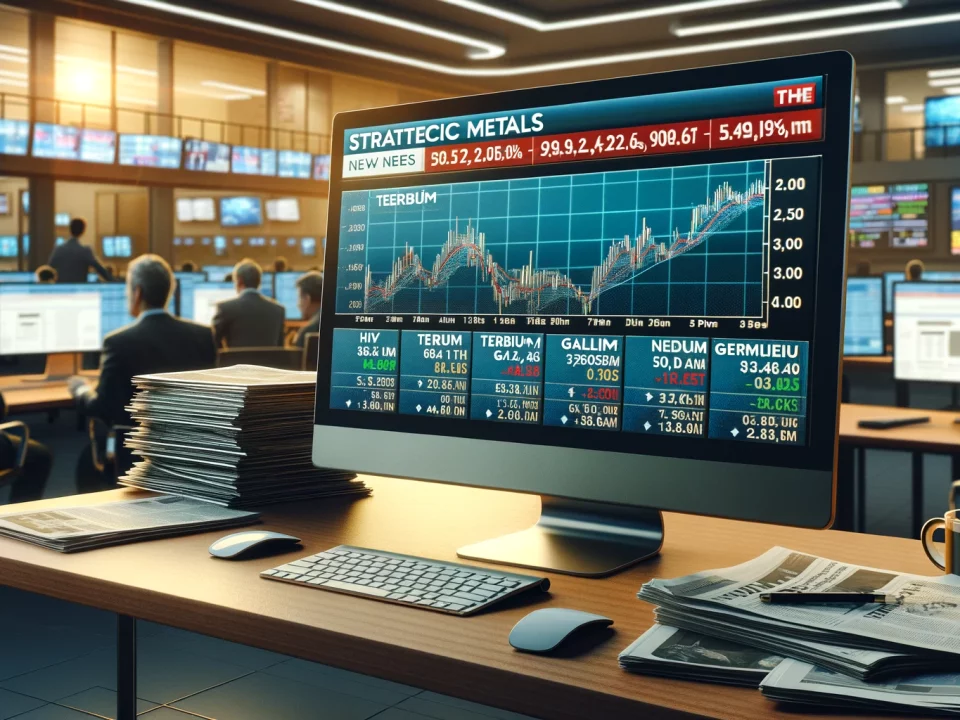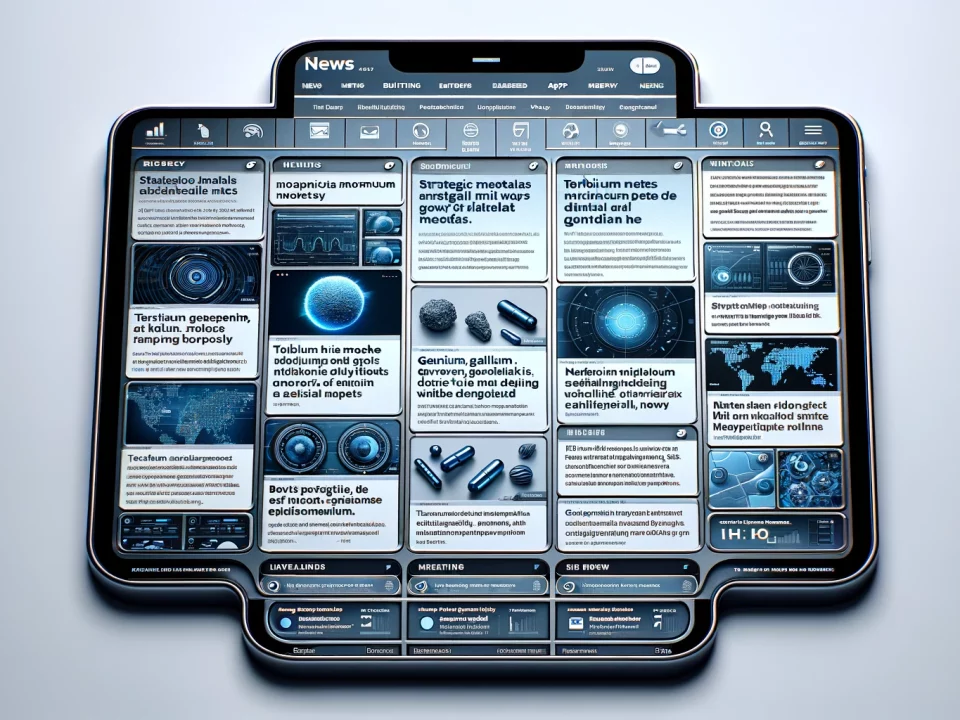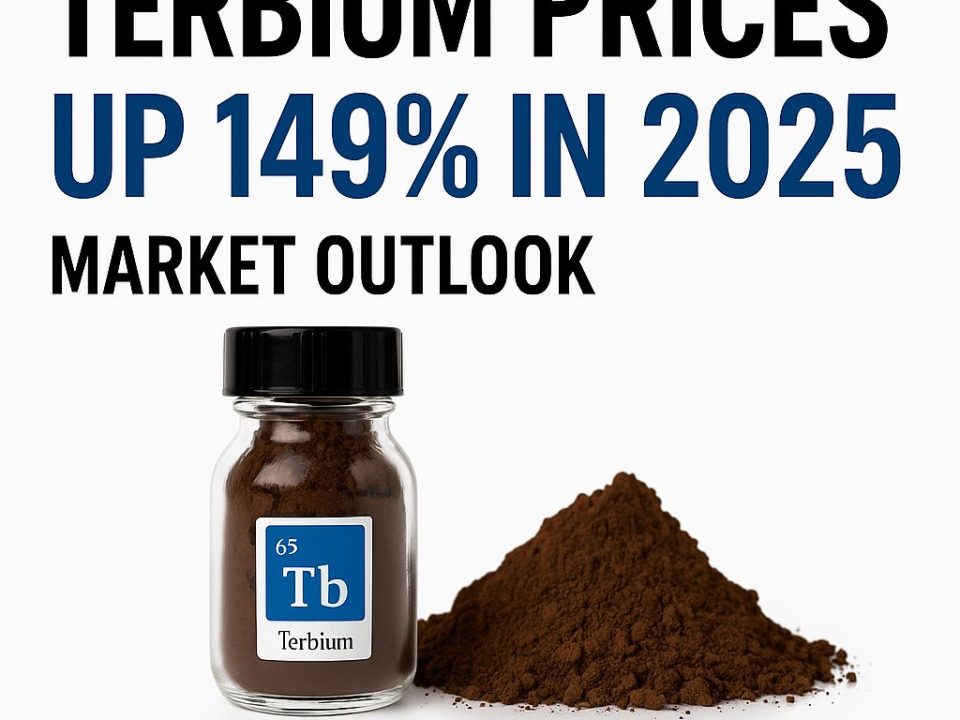
Weekly News Review July 14 – July 20 2025
July 20, 2025
Weekly News Review July 28 – August 3 2025
August 3, 2025China published a flurry of trade data this week, underlining Beijing’s market power in the critical minerals markets. Shipments of multiple raw materials stood at historic lows in June. Meanwhile, one of the leading contenders to rival China in the rare earths sphere, Australia’s Lynas, posted results for the past quarter.
All this and more from the newsroom in our weekly news round-up.
CHINA: EXPORTS OF DYSPROSIUM AND TERBIUM REMAIN AT HISTORIC LOWS –
The only shipments recorded in June were to South Korea.
Exports of dysprosium and terbium from China remained at historic lows in June, following a complete halt in May. According to Chinese customs data, just 1 kilogram of dysprosium and 1200 kilograms of terbium were exported, both to South Korea.
No shipments were recorded to other countries. Compared to June 2024, when China exported 26,037 kilograms of dysprosium and 8,590 kilograms of terbium, current levels remain severely depressed.
Since April, both heavy rare earth elements have been subject to China’s export licensing regime. As the world’s dominant producer, China’s restrictions have had a significant impact on global supply.
Dysprosium and terbium are vital to high-tech sectors such as semiconductors and chemical processing, but their most critical application is in neodymium-iron-boron (NdFeB) magnets. While not all NdFeBs contain dysprosium or terbium, these elements are crucial additions in magnets designed for high-performance and high-temperature environments, such as those found in electric vehicle motors, wind turbines, and advanced defense technologies.
In an unprecedented move, the Government-Set Quotas Not Public for the First Time:
Meanwhile, China has quietly issued its rare earth mining and smelting quotas on Friday, breaking from its usual practice of public announcements.
Sources did not disclose the specific volumes, as companies have reportedly been instructed not to share the figures. In 2024, the official quotas were set at 270,000 tons for mining and 254,000 tons for smelting.
CHINA: GALLIUM EXPORTS RESUME IN JUNE, GERMANIUM EXPORTS REMAIN AT A LOW LEVEL.
After a complete halt in May, China resumed gallium exports in June, according to the latest customs data. A total of 4,260 kilograms of the critical metal cleared customs in China last month. The two main destinations were Japan, with 2,004 kilograms, and Germany, with 2,000 kg, marking a partial recovery from May. In June 2024, China exported 4,184 kilograms.
Germanium exports, however, remain at a critically low level. Only 96 kilograms were shipped in June, down from 1,328 kilograms in the same month last year. Germany received 74 kilograms, while Russia imported 22 kilograms. Other major consumers, including Japan and the United States, did not receive any germanium shipments.
Both gallium and germanium are essential to high-tech industries, particularly in semiconductor manufacturing, fiber optics, and infrared systems. China is the world’s dominant producer of both metals. Since mid-2023, exports of gallium and germanium have been subject to a licensing regime, with official processing times of 45 working days. In practice, delays have often been longer, and exporters continue to face uncertainty. A ban on shipments of both metals to the United States, effective as of December 2024, remains in effect, further complicating global supply chains.
June also saw continued restrictions on other critical minerals, including dysprosium and terbium, with near-zero exports, and rare earth magnet shipments that, while recovering in volume, reflect fewer exports of high-performance grades due to export licensing.
CHINA: RARE EARTH MAGNET EXPORTS REBOUND IN JUNE BUT STILL LAG YEAR ON YEAR –
After a sharp drop in May, China’s exports of rare earth magnets saw a recovery in June. According to the latest data from Chinese customs authorities, 3,188 tons of rare earth magnets were exported during the month. Germany was the largest destination, receiving 764 tons, followed by the United States with 353 tons.
Despite the monthly rebound, exports for the first half of 2025 remained significantly lower than those for the same period in 2024. Total export volume was down 19% year-on-year, while export value dropped nearly 30%. The sharper decline in value relative to volume is likely due to a reduced share of high-performance rare earth magnets, which contain the heavy rare earth elements dysprosium and terbium. These elements have been subject to new export licensing requirements since April.
Although not all rare earth magnets include these restricted elements, Chinese customs currently classify all rare earth magnet exports under a single product code. This lack of differentiation has further complicated export processing and contributed to the ongoing slowdown.
CHINA: ANTIMONY EXPORTS PLUMMET IN FIRST HALF OF THE YEAR –
Following the implementation of export controls, the first six months saw only one-fourth of last year’s level clear Chinese customs.
China’s antimony exports have dropped sharply in the first half of the year, continuing a downward trend triggered by export controls imposed last year. Customs data show that only 107 tons cleared customs in June, 97% lower than the 3,199 tons recorded during the same month last year. Looking at the first half of the year, shipments have declined roughly 74% compared to the first half of 2024.
The decline follows China’s announcement in August 2024 to include antimony and its compounds on its list of export-controlled materials. Since mid-September, companies have been required to apply for official licenses to ship these materials abroad.
The immediate aftermath saw a surge in exports, peaking in September, as exporters rushed to beat the new restrictions. However, volumes collapsed in October and have since struggled to recover. The latest figures indicate a fresh leg downward.
China Flexes Its Critical Minerals Market Power:
As the world’s leading producer, China has significant market power, underlining the significance of further export curbs. The People’s Republic accounts for over half of the world’s mine production, with the refining capacities share estimated to be above 85%.
Antimony is a strategic metal used to harden alloys of lead and other metals. In the form of antimony trioxide, it is also crucial in the manufacture of flame retardants, making it a vital input in various industrial applications.
While antimony shipments have not completely dropped to zero, other critical minerals subjected to similar controls have. Exports of heavy rare earth elements, such as dysprosium and terbium, as well as key technology metals like gallium and germanium, plummeted to zero shortly after being added to the export control list and remain far below their former levels.
INDIA: RARE EARTHS MAGNET RECYCLING GAINS MOMENTUM –
India’s BatX and Germany’s Rocklink aim to strengthen their value chains, with commercial production planned within two years.
India is seeking to expand its high-tech sector while reducing its reliance on China, the country’s dominant supplier of critical raw materials. In a significant step toward this goal, the country’s first ecosystem for rare earth recycling and refining is set to take shape. BatX Energies Private Limited, an Indian recycling company, and Germany’s Rocklink GmbH have signed a Memorandum of Understanding (MoU) to collaborate on this effort.
The partnership aims to establish a scalable and sustainable recycling system for rare earth magnets, enhancing resource security not only for India but also for the European Union. Leveraging Rocklink’s take-back model, the companies plan to build a traceable collection network for end-of-life permanent magnets in India. They also intend to develop and commercialize solvent-extraction technologies to separate individual rare earth elements. A pilot plant is expected to be operational within one year, with full-scale commercial production targeted for completion within 24 months.
Building on an Existing Partnership:
According to the companies, this new initiative builds on an existing collaboration that led to the creation of India’s first recycling cluster for lithium-ion batteries and permanent magnets in Uttar Pradesh. BatX and Rocklink are already collaborating under the EU-India Trade and Technology Council, established in 2023 to enhance cooperation on trade, critical technologies, sustainable energy, and resilient supply chains.
As geopolitical tensions rise and supply chain disruptions become more common, recycling is gaining global importance as a secondary source of critical raw materials. In the rare earth sector, however, recycling remains underdeveloped. According to Germany’s Federal Institute for Geosciences and Natural Resources (DERA), the global recycling rate for rare earths stands at only around one percent. Key challenges include competition from low-cost Chinese products and the unpredictable availability of recyclable magnet waste.
Policy initiatives, such as the EU’s Critical Raw Materials Act and India’s national resource mission, aim to address these barriers by creating more substantial incentives and support frameworks for recycling and circular economy practices.
NORTH AMERICA: US DEPARTMENT OF DEFENCE INVESTS IN DOMESTIC TUNGSTEN PRODUCTION –
The U.S. Department of Defense has awarded $6.2 million to Golden Metal Resources, a subsidiary of Guardian Metals, a U.K.-based company, to advance its Pilot Mountain tungsten project in Nevada. The funding, issued under the Defense Production Act (DPA), is the third Defense Department investment in the domestic tungsten supply chain since 2024.
Located southeast of Hawthorne, Nevada, Pilot Mountain is believed to be the largest undeveloped tungsten deposit in the United States. Golden Metal Resources will use the funding to conduct geological testing and deliver a pre-feasibility study for the project.
Tungsten is considered a strategic metal due to its exceptional hardness, high density, and the highest melting point of any element at 3422 °C. These properties make it indispensable for military and industrial applications. Notably, it is required for both the production of advanced armor and armor-piercing ammunition, underscoring its importance to the defense sector.
Despite its importance, the U.S. remains heavily reliant on tungsten imports, with no active domestic mines having been operational since 2015. Currently, China dominates the global tungsten market, producing over 80% of the world’s supply. In February, Beijing added tungsten to its list of export-controlled items, making shipments abroad subject to license requirements.
DOWN UNDER: LYNAS RARE EARTHS (AUSTRALIA) REPORTS 25% REVENUE JUMP –
Australian rare earths producer Lynas Rare Earths has reported a 25% year-on-year increase in quarterly revenue for the period ending June, driven by higher production volumes and improved selling prices. According to the statement (PDF), the company generated $112.62 million (AUD 170.2 million) in sales revenue, up from $90.39 million (AUD 136.6 million) in the same quarter of the previous year.
Lynas also reached a significant production milestone during the quarter, reaching an output of 2,080 tons of neodymium-praseodymium (NdPr), the first time it has surpassed 2,000 tons in a single quarter. This quarter marked the first commercial production of the heavy rare earths dysprosium and terbium, making Lynas the first company outside China to do so.
In a separate announcement (PDF), the company revealed it had signed a memorandum of understanding (MOU) with Korean permanent magnet manufacturer JS Link to build a magnet plant in Malaysia. The planned facility is expected to have an annual production capacity of 3,000 tons.
Lynas also noted that discussions are ongoing with the U.S. government regarding potential financing for its magnet plant currently under construction in Texas. The move aligns with broader efforts in the U.S. to secure critical mineral supply chains.
Earlier this month, U.S.-based MP Materials, the country’s largest producer of rare earths, received significant backing from the U.S. Department of Defense, including a price floor for NdPr.
UNITED STATES LAUNCHES PUSH TO RECOVER CRITICAL MINERALS FROM ABANDONED COAL MINES:
The United States is ramping up efforts to strengthen its critical mineral supply chains by tapping an unlikely source: mine waste. On Thursday, the Department of the Interior (DOI) announced a new initiative in line with ongoing federal efforts to enhance domestic resource security. The DOI aims to streamline federal regulations, make mine waste recovery projects eligible for federal funding, and prioritize the review of plans to extract critical minerals from abandoned mines.
The U.S. Geological Survey (USGS) has also been tasked with mapping and inventorying mine waste sites nationwide to support this initiative.
Reviving abandoned mining sites could secure essential supplies for U.S. industry while creating jobs in local communities, the DOI said. For example, one legacy lead and zinc mine in Oklahoma was found to contain significant amounts of germanium, a strategic metal used in electronics and optics, and primarily produced by China.
Similarly, rare earth elements have been discovered in clay deposits at former coal sites across Appalachia, another mineral group largely dominated by Chinese producers.
Communities in former coal-producing regions have struggled economically as the energy transition away from fossil fuels has progressed. In Appalachia alone, over 37,000 coal-related jobs were lost between 2011 and 2021, according to the Appalachian Regional Commission (PDF). Repurposing these sites for critical mineral extraction could both reduce foreign dependencies and deliver new economic opportunities to affected regions.
The Federal Mining Dialogue estimates that over 500,000 abandoned coal mines exist nationwide, which could be viable sources of valuable materials.
GALLIUM AS A CANCER TREATMENT?
Researchers at Ruhr University Bochum are developing a new approach to fight cancer cells beyond the primary tumor site.
Critical raw materials, such as rare earth elements and gallium, are often mentioned in the same breath as renewable energy, electric vehicles, or military technology. Less well known is the significant role many metals play in medicine, not only in technical devices such as MRI scanners, implants, or lasers, but also as active pharmaceutical ingredients, particularly in cancer treatment.
At Ruhr University Bochum in Germany, a new gallium-based compound has now been developed. According to the researchers, it not only destroys cancer cells but can also train the immune system to recognize and eliminate metastases. In other words, the body develops a kind of long-term memory for cancer cells, even when they are located far from the original tumor.
Immune System Receives Warning Signals:
Dr. Johannes Karges, one of the lead scientists, explains the principle behind the compound: the gallium complex penetrates the cells and, due to specific properties, induces oxidative stress in the endoplasmic reticulum. This membrane system is involved in cellular detoxification and metabolism.
According to Karges, the gallium complex triggers a response that only very few drugs can: a process known as immunogenic cell death. During this process, proteins from the endoplasmic reticulum and the cell nucleus are released, which serve as warning signals for the immune system. As a result, the immune system learns to recognize cancer cells as a threat and responds by attacking them.
The compound has already been successfully tested on cervical cancer cell lines. The next step is to refine it further so that it targets specifically cancer cells and not healthy tissue. To that end, Karges and his team are working on activation methods that utilize external triggers, such as ultrasound or light.
This line of research could pave the way for new, holistic approaches to cancer therapy, especially since metastases are still responsible for about 90 percent of all cancer-related deaths.
EXPORT RESTRICTIONS: ARE CHINA AND THE EU MOVING CLOSER ON RARE EARTHS?
Beijing and Brussels agree on a new export mechanism — details and impact remain unclear.
According to media reports, the European Union and China have taken a step toward resolving their dispute over rare earth exports. Global supply of these critical raw materials has been under pressure since China, the world’s dominant producer, introduced new export controls and a licensing system for certain rare earth elements in April. In May, for example, exports of dysprosium and terbium dropped to zero.
Now, both sides have reportedly agreed on an “improved mechanism” aimed at increasing transparency in the licensing process and avoiding further supply disruptions. “We have agreed on a better mechanism for export transparency,” European Commission President Ursula von der Leyen said Thursday following the EU-China summit in Beijing. However, she offered no further details, leaving unanswered which exports will be affected or whether China will receive any concessions in return.
Von der Leyen added that the EU is pushing for a broader realignment of its trade relationship with China, emphasizing the principles of fair competition and free trade. In addition to better market access for European companies, she highlighted concerns over Beijing’s subsidies and the resulting industrial overcapacities.
Industry Cautiously Optimistic, but Challenges Remain:
Jan Giese, Senior Manager for Minor Metals and Rare Earths at TRADIUM GmbH, one of Europe’s largest raw material traders, described the announcement as another encouraging political signal. However, he noted that it remains to be seen whether this will result in any concrete easing of export volumes in the coming weeks. Giese also cautioned against easing efforts to diversify supply chains, citing the rapidly shifting and uncertain geopolitical environment of today.
Earlier this month, the United States and China also signaled progress in separate discussions regarding the trade of rare earth elements.
However, the long-term effects remain unclear here as well. While China resumed some shipments of rare earth magnets to the U.S. in June, it continued to withhold exports of the strategically important metals dysprosium and terbium.
Figure of the Week: – $9.8% BILLION – has been invested in nuclear fusion by the private sector since 2021.






